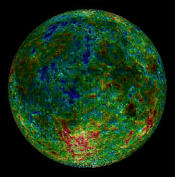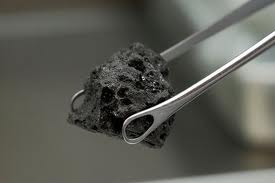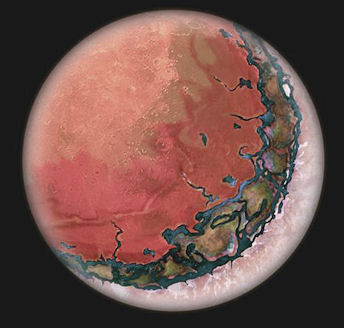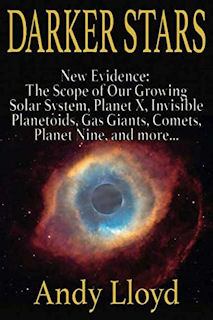It is said that extraordinary claims require extraordinary
evidence. The evidence for the early migration of the Earth (or possibly
the Earth/Moon binary system) takes the form of the water in various parts of
the solar system. This water, which consists of a mixture of isotopes, carries
its own signature, which various according to where in the solar system the
water first formed. Similarly, isotopic signatures can be derived from the
elemental composition of rocks, helping scientists to slowly piece together the
puzzle of the early solar system. Results are proving surprising.

The arguments involved become complex (and I have tried to do
them justice in my book Dark
Star, as well as on in-depth analysis on the
Dark Star Theory website)
but the picture that emerges from the evidence is that the water on Earth and
the Moon is unexpectedly abundant, given how close they are to the Sun, and that
the idea of water being brought to the Earth and Moon by comets is an
insufficient explanation for what we see here.
I have therefore argued that the best explanation for what we see
is that the Earth system initially formed where the asteroid belt is currently
now, and migrated in to its current position following an early catastrophic
event (involving the Dark Star). The more distant location for the early
Earth provides us with a strong explanation for why the Earth has so much non-cometary
water on it: it was too far from the Sun for the early solar heat to have driven
the volatile water off. Such a scenario is in keeping with Zecharia
Sitchin's theories of where the Earth formed.

Further grist for this particular mill is now provided by recent
studies of moon rocks which, when combined with the newest theories of Moon
formation, lead the scientists in exactly the same direction. Here's the
quote from New Scientist:
"So if the moon's water
came from Earth, where did Earth's water come from? The impact that formed the
moon happened within about 100 million years after solid bodies began to form in
the solar system – an eye-blink in astronomical timescales. [Alberto] Saal
[of Brown University, R.I.] doubts that Earth could have accumulated enough
water from asteroid strikes in that time. "The implication, although I
cannot absolutely prove it, is that probably the Earth formed with water," he
says. The trouble is that our planet is currently too close to the sun for it to
have retained water as it coalesced from the swirling disc of material that was
to become the solar system.
Saal thinks that Earth may
have formed near where the asteroid belt is now, which is far enough from the
sun for water to condense. The planet would then have migrated inward. It'll be
a tough theory to prove, because Earth's geologic activity has been recycling
rocks, and thus erasing the evidence, for billions of years. That's what makes
moon rocks so valuable.
"All that we know now
is because we have a fossilised record of what happened 4.5 billion years ago on
the moon," says Saal. "We couldn't get that conclusion from looking at the
Earth." (1)
It appears that the interior waters of the
Earth and Moon have the same source (2), leading to the conclusion that they
were always there from the beginning of the life of Earth. I would
imagine, then, that should the Inward Migration Hypothesis be correct, then we
should find similar water compositions among the asteroids in the main belt.
After all, if the Earth started its life there and was catastrophically
expelled, then shouldn't at least some of those asteroids have been part of the
early Earth?
The composition of some meteorites suggests
planetary origins, or at least that the were once fragments of very large
planetessimals early in the life of the solar system:
"What is most unusual about
these rocks [designated GRA 06128 and GRA 06129] is that they have compositions
similar to Earth's andesite continental crust - what makes up the ground beneath
our feet," says University of Maryland's James Day, lead author of the study.
"No meteorites like this have ever been seen before."
(3)
A smoking gun may be around the corner as
space agencies and mining companies turn their attention towards asteroids.
Scientists working with the data from WISE are currently piecing
together the history of the asteroid families, projecting back in time to glue
the pieces of the original 'vases' together. It seems evident to me that Sitchin's work is receiving
further vindication from cutting-edge science, and that these endeavours will
soon offer his idea some long-awaited proof.
Sceptics argue that there is no evidence that
a planet larger than Mars ever existed in the zone currently occupied by the
asteroid belt. Furthermore, the very presence of mighty Jupiter in this
region makes the probability of the formation of a terrestrial planet not just
low, but virtually impossible.
"“There’s a not a single
piece of concrete evidence that would suggest that there ever was a full-sized
planet in the asteroid belt,” said Nick Moskovitz, a planetary scientist at
M.I.T. “In the region of the Main Belt, it’s dynamically impossible in the
presence of Jupiter’s gravitational influence for small bodies to collide and
stick together to form a full-sized planet.”
"In truth, the mass of the
Main Belt — which extends just past the orbit of Mars to about three and a half
times the distance from the Earth to the Sun — has not changed much over the 4.5
billion year life of the solar system. Moskovitz says the belt that we see today
is the result of a population of bodies that have spent the subsequent 4.5
billion years interacting and colliding with one another."
(4)
I'm generally sceptical when sceptics make
such sweeping generalisations. The history of science is awash with
examples of such bold statements proving laughably erroneous years later.
One only needs to review the remarkable variety of extra-solar planets
discovered in the last decade or so to see how theoretical positions held by
astronomers beforehand subsequently required serious revision.
Written by Andy Lloyd, 20th-31st May 2013
References:
1) L. Grossman "Moon Water Came From Young Wet
Earth" 9 May
2013
with thanks to Lee and Beau
newscientist.com article
2) A. Saal, E. Hauri, J. Van Orman & M. Rutherford
"Hydrogen Isotopes in Lunar Volcanic Glasses and Melt Inclusions Reveal a
Carbonaceous Chondrite Heritage" Science, 340 (6138):
1317-1320, 14 June 2013,
science.org article
3) Science Daily "Half-Baked
Asteroids Have Earth-Like Crust" 8 Jan 2009 with thanks to Lee
sciencedaily.com article
4) T.
Phillips "New Asteroid Families Discovered" May 2013
science.nasa.gov news







